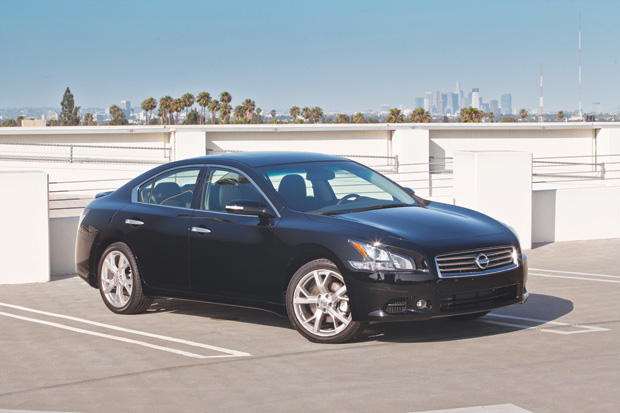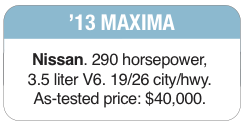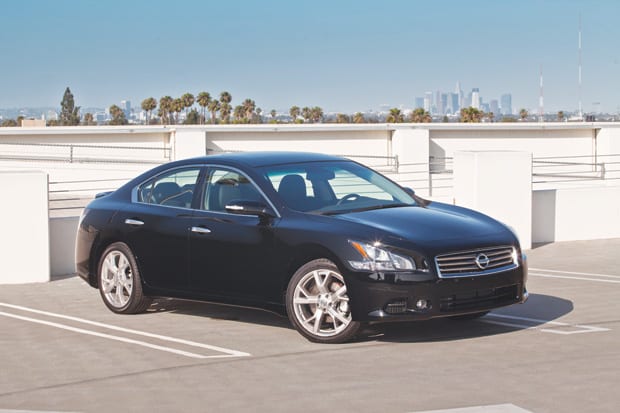Is Nissan’s Maxima still a 4-door sports car? Take a look

SPORTY CROSS | Combining an interior that’s part Nissan Z and part Infiniti Q, the Maxima is starting to feel its age but still has power and appeal. (Photos courtesy Nissan)
CASEY WILLIAMS | Auto Reviewer
crwauto@aol.com
 Nissan’s Maxima was once billed as a four-door sports car, and in its day, it was about as performance-oriented as a Japanese mid-size sedan could be. Since then, Nissan introduced the incredibly popular Altima and an entire line of rear-drive performance models known as Infiniti. The question becomes, then: Is the Nissan Maxima still a 4DSC (as the sticker in the rear window says)?
Nissan’s Maxima was once billed as a four-door sports car, and in its day, it was about as performance-oriented as a Japanese mid-size sedan could be. Since then, Nissan introduced the incredibly popular Altima and an entire line of rear-drive performance models known as Infiniti. The question becomes, then: Is the Nissan Maxima still a 4DSC (as the sticker in the rear window says)?
That depends on what you classify as a sports car. Yes, the Maxima is plenty sexy with bulging fenders, flared hood edges, fastback roofline, 18-inch alloys shod with low-profile tires and wing-shaped LED taillamps. It was purposely designed to resemble the 370Z sports car, from the angle of the fire-swept headlamps to the frump of its trunk. Even the chrome grille looks beefy.
Slide inside for a mix of the Nissan Z and Infiniti Q. Sporty and luxurious, the heated three-spoke leather-wrapped steering wheel, large analog gauges, sport shifter, heated leather seats and automatic climate control make driving like Andretti as comfortable as dressing like Armani. Touch screen navigation, premium audio, power sunroof, Satellite Radio, back up camera, USB and Bluetooth meet current standards. Dual front, side and side-curtain airbags enhance safety.
From behind the wheel, the hood curves, center console and steering wheel position could trick you into thinking you’re piloting a C5 Corvette. While definitely softer, the suspension has a firm float that is a facsimile of the touring setting on the old Chevy. A relatively long steering column stretches to one’s hand and is light to the touch at low speed with rapid progression in corners and on the highway. Typical front-end push, common in front-drive cars, is almost non-existent in the Maxima.
 Out on the road, the Maxima is aging gracefully.
Out on the road, the Maxima is aging gracefully.
Under the hood and on the road, the 290-horsepower 3.5-liter V6 makes full use of the chassis. Power is smoothly routed through a continuously variable transmission (CVT) that uses no traditional gears, but infinitely changes ratios for the best setting. Sounding unsettlingly like a velvet Weed Eater at first, you soon appreciate how it does its thing without any drama.
Four-wheel anti-lock disc brakes, traction control, electronic stability control, brake force distribution and brake assist (will throw you through the windshield if applied aggressively) give the Maxima agile legs. Fuel economy ratings of 19/26-MPG and a 20-gallon tank extend range to bladder-busting lengths. To get optimal power, Nissan’s grandest sedan appreciates top grade fuel.
Remember, this generation of the Maxima has been on the market for nearly four years. A lot of great cars have come on, and Nissan’s sporty sedan is starting to feel its age. As with all of us when we are no longer the club queens we once were, the car squeaks and creaks in ways newer cars don’t. While the Maxima may not be everybody’s idea of a 4DSC, it is a very good car.
An as-tested price of $40,005 puts it against the Buick LaCrosse, Toyota Avalon, Hyundai Azera and VW Passat.
This article appeared in the Dallas Voice print edition July 26, 2013.

